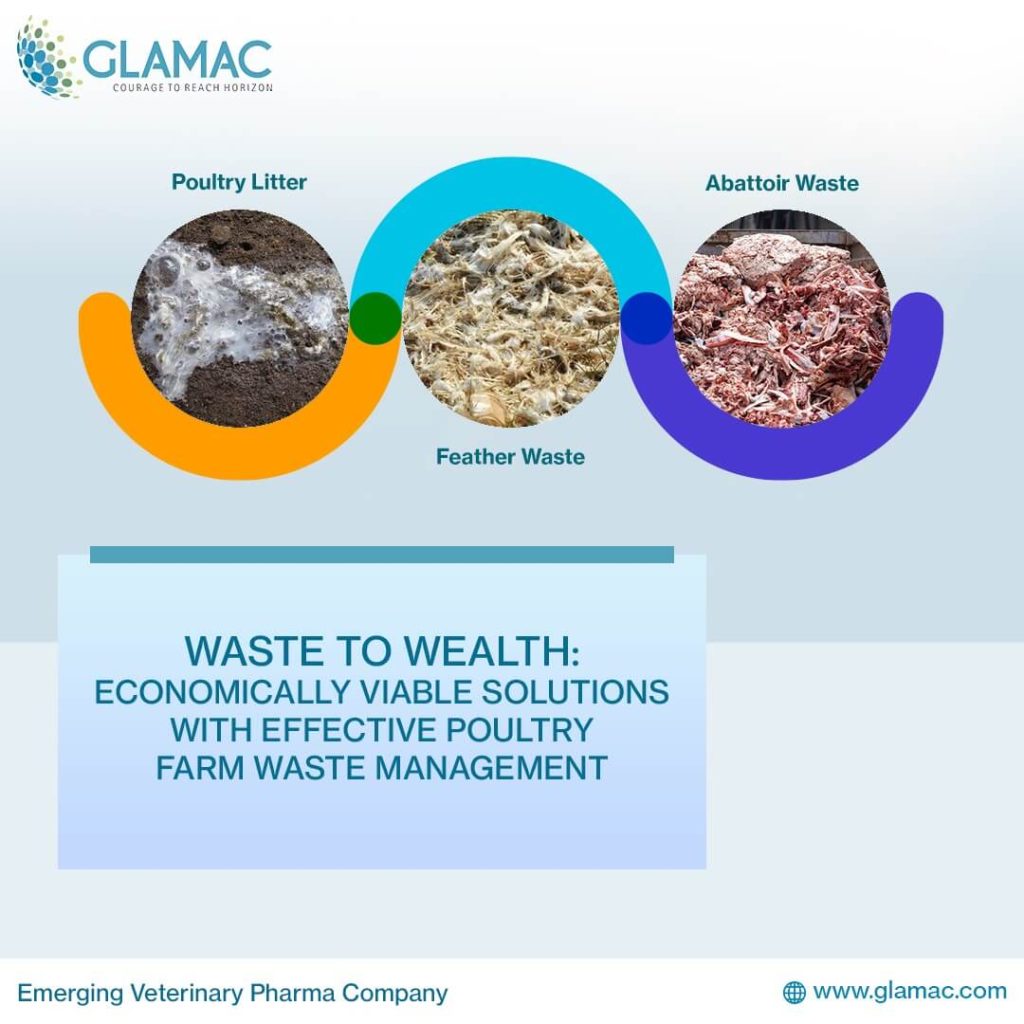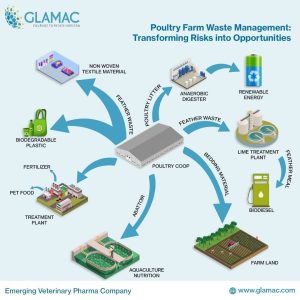Waste to Wealth: Economically Viable Solutions with Effective Poultry Farm Waste Management
As the poultry sector is emerging rapidly as one of the key contributors to economic growth, so is the alarming concern of poultry farm waste. Poultry waste if not treated properly can have a detrimental impact on the environment, human health as well as the flocks. Currently, the Indian poultry sector alone produces around 3.30 million tonnes of waste per year which needs a sustainable management approach for turning waste into wealth.
This large volume of hatchery waste includes solid waste and wastewater. The solid waste consists of bedding material, feces, empty shells, feathers, dead embryos, dead chickens, and decaying tissues. Whereas wastewater is the water used for washing incubators, and chick handling areas, from where feces and urine get mixed in the water, besides, blood, sawdust, remnants of drug pesticides, residual acids, and metals.
India’s poultry sector is currently the fastest growing segment with an impressive growth rate of 12.39%, making it the 3rd largest egg producer and 4th largest chicken meat producer in the world. This extensive production scenario is directly linked to the large volume of poultry waste produced by the poultry sector, which needs to be managed responsibly. A sustainable approach in poultry farm waste management not only neutralizes adverse environmental impacts but also unleashes promising business opportunities through waste recycling and processing. Currently, the major concern in poultry waste management in most developing and under-developed nations is disposing of the waste by burying, rendering, or landfilling. Unfortunately, each of these processes is not scientifically feasible and leads to more pollution by contaminating soil, air, and water. Moreover, the costs involved in the large-scale waste disposal process are an added concern, especially for small-ticket poultry farm owners.
A glimpse of adverse poultry waste impact on the environment:
If not managed responsibly, poultry waste can lead to detrimental environmental and health challenges such as:
Alarming water pollution: Poultry waste is high in nitrogen and phosphorous, which when reached by waterways can cause eutrophication. The contamination leads to excess algal growth that depletes the oxygen level and harms aquatic life. Besides, runoff wastewater from farms can directly contaminate water bodies, ponds, and rivers. This runoff wastewater contains pathogens, antibiotics, and chemicals that can severely compromise water quality by making it unsafe for even basic regular use. Getting in contact with such contaminated water can even lead to chronic skin conditions and even cancer in humans as well as other organisms.
Degrading air quality: Dumping poultry waste in landfill is not the end of the problem, but the beginning of the bigger one. A large volume of poultry waste in farms and landfills emits ammonia and hydrogen sulphide. These harmful gases not only degrade the air quality with obnoxious odor but also causes chronic respiratory syndrome among farmworkers and inhabitants in close proximity to the landfills.
Pathogen contamination: Improper handling of poultry waste without proper precaution and gloves can lead to the spreading of pathogens like Salmonella, Campylobacter, and E. Coli to cause unknown fever and infections. Moreover, the residues of the antibiotics in the waste when entering the environment can lead to the formation of antibiotic-resistant bacteria, posing a threat to human immunity.
Emission of greenhouse gas: Decaying poultry waste emits methane, a potent greenhouse gas besides ammonia which when react with other pollutants in the atmosphere for fine particulate matter impacts both human health and the environment.
Odor and Nuisance: Unscientific way of meat and poultry waste management attracts pests and scavengers to unearth the buried waste and cause disturbances in the nearby communities. Plus, the foul odor from the farm often leads to never-ending conflict between the farm owners and nearby inhabitants.
Poultry farm waste management: Transforming risks into Opportunities
Before we put forth the feasible ways to mitigate poultry waste risk through recycling, let’s first understand the classification of poultry waste, primarily responsible for pollution.
Poultry litter: Poultry litter or manure is the main waste generated by the poultry farm. It has been found that a healthy poultry bird would produce approximately 1 kg of litter within a 47-day growing-out period. While in some cases the litter quantity has been noted higher within the 42-day production cycle for each bird.
Feather waste: Poultry feathers are second concerning farm waste massively generated by the global poultry industry accounting for millions of tonnes.
Abattoir waste: These are organic solid by-products produced through slaughtering, blood, offal, visceral organs, feet, head, and bone. Improper management of this solid waste greatly increases the risks of bacterial transmission.
Remodeling poultry litter in 4 ways:
- Poultry manure consists of bedding material with high carbon content biomass that is mainly straw, sawdust, peanuts, shredded paper, and rice bran. Due to the presence of high plant nutrients, poultry litter is high in nitrogen, phosphorous, and potassium, making it one of the ideal manure to increase soil fertility and soil’s water-holding capacity.
- Poultry litter is processed to produce biogas, an innovative and sustainable waste management solution that can address both environmental and energy challenges. After collecting the litter from the farm, the waste undergoes pre-treatment before being fed into an anaerobic digester, which is a sealed oxygen-free container. During the process, naturally occurring microorganisms break down the organic matter of the litter to produce biogas which is mainly composed of methane (CH4) and carbon dioxide (CO2). Biogas generated from poultry litter is a valuable source of renewable energy.
- Chicken litter can be used to produce green energy through mass burn combustion, where the waste is burned in incinerators to produce electricity.
- Poultry litter can be valuable for research and educational purposes, allowing scientists and students to study its properties, nutrient content, and environmental impacts.
Remodeling poultry feathers in 4 ways:
- The keratin in chicken feathers when treated with lime leads to the formation of a liquid product rich in amino acids and polypeptides. This feather by-product is a potent animal feed supplement, also known as feather meal.
- Because of high nitrogen content and fat, feather meal can be further processed to produce bio-diesel. Biodiesel obtained from feather meal has been tested to be of good quality.
- Chicken feathers have wide applications in the production of non-woven textile materials and the field of technical textiles.
- Feather waste is now also being converted into biodegradable plastics that are widely used for the production of plastic cups and plates.
Remodeling Abattoir waste in 4 ways:
- Certain by-products from poultry processing, such as blood meal, feather meal, and poultry offal, can be processed and used as ingredients in animal feed formulations. These by-products are rich in proteins, fats, and minerals, making them valuable sources of nutrition for livestock and aquaculture species.
- Poultry abattoir waste, along with other organic waste materials, can be composted to create nutrient-rich organic fertilizers. Compost helps improve soil structure, enhances water retention, and provides essential nutrients to plants, promoting sustainable agriculture.
- Abattoir waste rendering involves processing poultry abattoir waste into valuable products like poultry fat, poultry meal, and bone meal. These rendered products have applications in various industries, including animal feed, pet food, and bioenergy.
- Poultry abattoir waste can be used as a resource for producing biodegradable materials, such as bioplastics, reducing the environmental impact of plastic waste.
Bottom Line: To mitigate the adverse impact of poultry waste, proper poultry waste management practices are essential. These may include adopting technologies like composting and anaerobic digestion to recycle waste, implementing nutrient management plans to optimize fertilizer use, and following strict biosecurity measures to prevent disease outbreaks and pathogen transmission. By taking proactive measures to manage poultry waste responsibly, the poultry industry can reduce its environmental footprint and contribute to a more sustainable agricultural system.


